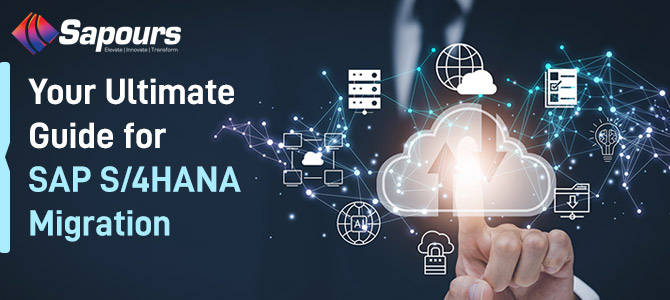If an organization relies on SAP to run its critical business processes, it must accommodate the transition from SAP ECC (Enterprise Core Component) to SAP S/4HANA.
SAP is firmly focused on adopting its next-generation ERP platform, S/4HANA. For the same reason, the enterprise software pioneer has given a deadline of 2027 to move from the old SAP ERP to the new S/4HANA. But this deadline is not the only reason to switch to SAP S/4HANA.
Why Migrate to S/4HANA?
- Simpler user interface
- Process automation
- Real-time analytics to promote informed decisions
- Easy-to-update business models
- Quarterly automatic updates
- Easy access to AI, chatbots, and IoT
- Speedy financial closings
- Standardize business operations and processes globally
- Enhance customer service by reducing complaints
To reap these benefits, you need to set up the systems in the SAP S/4HANA environment, which requires a major commitment of resources and time. As the migration process is highly complex, it is essential to have a clear-eyed view of the steps and challenges of SAP S/4HANA migration.
SAP S/4HANA Migration Approaches
Greenfield
This approach is a fresh start where a new ERP system runs on the latest cloud infrastructure or data center. It can be the first ERP of the organization as well. The greenfield deployment mainly involves switching from the older SAP system or another ERP vendor.
Moving data and training employees on a new system are challenging affairs. Still, this approach is considered the best to get all the benefits of S/4HANA, including predictive analytics, process automation, artificial modeling, and real-time reporting.
Here is how we helped a large auto component manufacturing company achieve 60% reduction in manual work and 30% increase in efficiency with SAP S/4 HANA implementation.
Starting with S/4HANA Finance
This is one of the most common approaches to S/4HANA migration. The organization can start with the financial module, and later, they can move to other modules.
This kind of partial migration is feasible because accounting is a conventional back-end process and does not change much. The migration to the finance background can be conducted without any disruption. The move to S/4HANA central finance is also called the brownfield approach.
SAP RISE
RISE with SAP is a bundled service where the customers can quickly get up and running on S/4HANA and the overall ecosystem. It also includes the procurement network of SAP Ariba and intelligent business process reengineering.
The ERP system runs on the public cloud, such as the Azure Cloud or Amazon Cloud. The consulting and implementation partners follow their methods and tools for the implementation of SAP S/4HANA outside of RISE with SAP. It helps automate the testing process of ERP program code to determine the move to S/4HANA.
How To Choose the Right S/4HANA Migration Approach?
The choice of migration approach comes up in the design phase of implementation when the organization sets the initial roadmap. The consulting partners offer appropriate planning and strategy to analyze specific factors to determine the best migration method. This phase is considered phase zero and aligns well with the early stages of SAP implementation.
Here are the key steps to choosing the most suitable migration approach:
- Evaluation of the existing system: This step involves assessing the existing ERP system, the data, and business processes impacted by the system. The maintenance and licensing costs are also evaluated, along with the users’ pain points.
- Review of architecture: The existing ERP modules and business processes are determined and mapped with the available modules of SAP S/4HANA and deployment options.
- Analysis of future state: In this step, the user requirements are gathered from executives, department heads, and other stakeholders to envision the working process of the new ERP.
Key Steps to a Successful SAP S/4HANA Migration
Migrating to SAP S/4HANA offers enormous business opportunities, but it also poses various challenges. To that end, below are five key steps to ensure a smooth migration.
1. Get a Clear Picture of the Current State
Assess the current SAP environment and the benefits of migrating to S/4HANA. In this step, the current SAP systems will be identified to learn if the recommended suite meets the business requirements.
2. Create a S/4HANA Roadmap
The roadmap will indicate how S/4HANA can meet the current business needs and the ways to achieve the desired goals. In this step, the entire IT landscape will be evaluated by understanding SAP S/4HANA functions, system component requirements of SAP S/4HANA, a suitable time to migrate the components, changes to the current SAP environment, and the impact of third-party systems.
3. Design Your Architecture
Look at the design of the SAP environment and decide the required changes. This step considers providing service to the business users. For example, SAP S/4HANA provides remote access and allows users to access data from mobile devices easily.
4. Train End Users
Migrating to SAP S/4HANA requires new user interfaces, technologies, and processes within the enterprise. So, this step considers the training requirements for implementing the SAP environment.
5. Cooperate with Third Parties
The changes to the SAP environment impact hosting infrastructure and managed services offered by the provider. This step involves taking feedback from the business users and third-party service providers.
Choosing the Right S/4HANA Implementation Partner
SAP S/4HANA migration is one of the most crucial upgrades of the SAP platform. When implemented successfully, the project will bring you a better return on investment and help you adapt to the industry’s evolving changes.
At Sapours, we help transform business processes with our experienced team of SAP-certified professionals to achieve the true benefits of S/4HANA. If you are looking for expert guidance to plan your SAP S/4HANA migration successfully, schedule a free consultation with us today.

